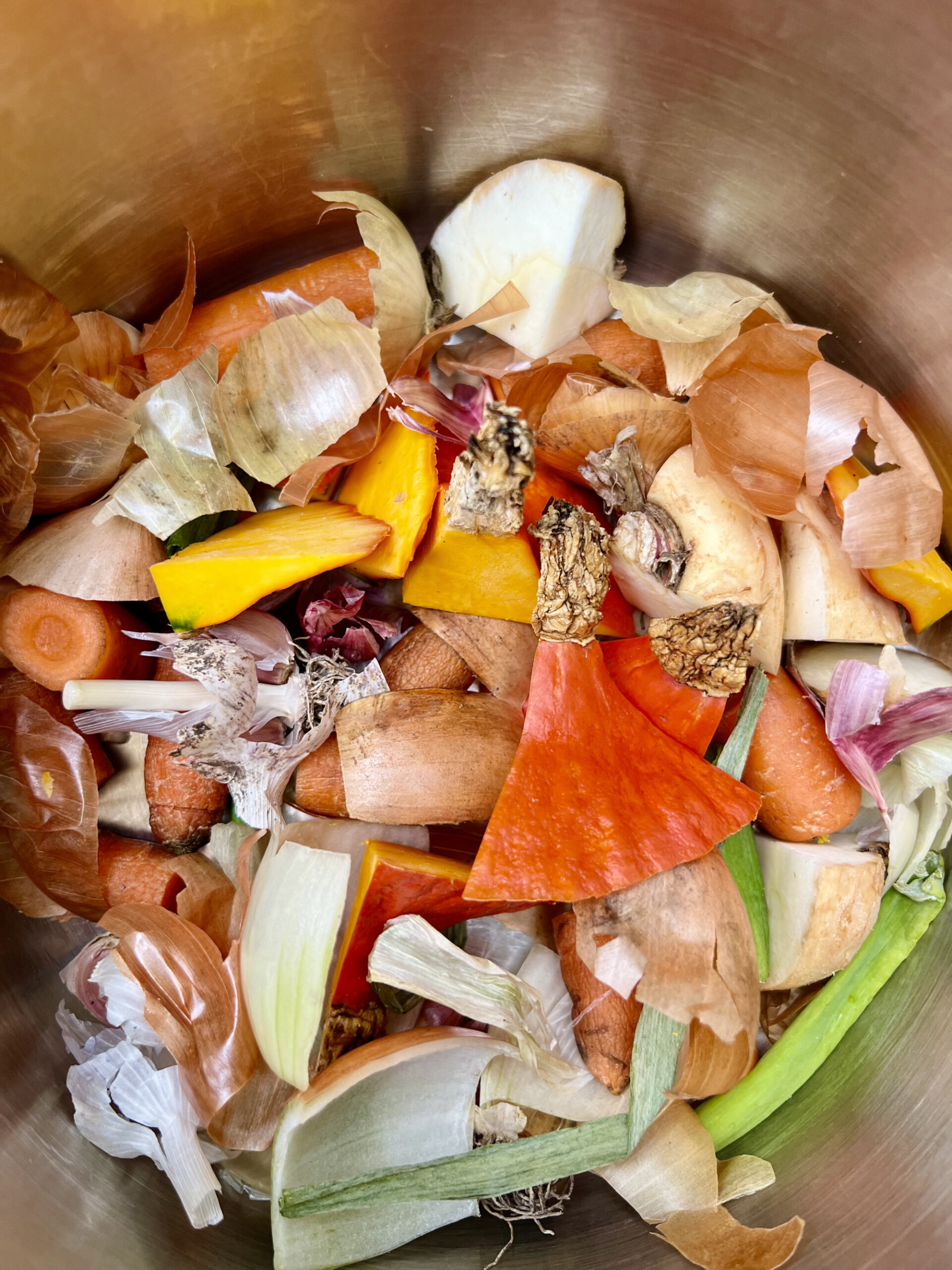
Trust me guys. There is nothing better than homemade vegetable stock. Technically, we will be making more of a vegetable broth, but let’s not get too nerdy with the terms, as they are used interchangeably most times anyways. But back to the flavour: The richness and depth are unparalleled to any store-bought alternative. Here, you will find inspirations to find your own best vegetable stock recipe!
With delicious vegetable stock, you will have a strong base to build any dish, such as risotto like this amazing roasted pumpkin one, or this warming garlic soup. Another great detail: It costs basically nothing to make, as you can use ingredients that would otherwise go to waste. So, let’s get started making great, homemade no-waste veggie stock!
This recipe provides you with some ideas for choosing what kind of vegetables to use for your stock. That is the beautiful thing about making vegetable stock at home. It gives you the full authority to customize the taste of whatever dish you want instead of depending on the taste of the store-bought alternatives. Still, there are ingredients that work well and some you should avoid using, which we will get into now.
What you need for this Recipe:
In this vegetable stock recipe, there are two things key to getting the best results: Firstly, having a good mix of your ingredients on hand. Secondly, take the time to simmer them well. I like to collect cooking waste that works for my stocks in freezing bags and have a good collection on hand in my fridge. That way, I always have a good mix of food scraps on hand when I need to make vegetable broth. Today, I am making some stock for an amazing roasted pumpkin risotto, so this reflects in my choice of ingredients. I would have also liked to include mushrooms, sweet potato and celery, but those were nowhere to be found in my scrap bags. Hey, that’s how it is sometimes. The broth turned out amazing nevertheless!
The Best Vegetables for Homemade Vegetable Stock:

Veggies that work particularly well to make vegetable stock are carrots, leak, onions, celery, mushrooms, garlic, spring onion, pumpkin, or parsnips. All these will give a rich flavour to your broth. Furthermore, using herbs such as thyme, parsley, basil, or bay leaves is delicious. You won’t even need to sacrifice your precious fresh veggies to make the stock. I usually use waste parts. So, the tops of carrots, parsnips, the stems of mushrooms, the skin and ends of onions, pumpkin, the roots and dry ends of spring onions, and the branches of parsley are what I tend to use for the stock.
Vegetables to Avoid:
Nevertheless, there are some vegetables to be wary of. From my experience, any cruciferous vegetables, such as broccoli, cauliflower, cabbages and radishes, should be left out when making your stock. They can develop weird sour and bitter notes, which I find undesirable for most occasions. Also, any vegetables that give off aggressive colour when cooking will also colour your stock. If you don’t want this effect specifically for some funky dishes, I would recommend abstaining from red beets or fresh turmeric.
How to make Homemade Vegetable Stock:

Depending on the quantity you intend to produce, take your prepared vegetables/food scraps. For an approximate reference, I used the peel and ends of four onions, four cloves of garlic, four carrots, the end of one spring onion, the end of a pumpkin, the tip of a parsnip, a few peppercorns and a bay leaf to make 1 ½ litre of vegetable stock.

Make sure to wash your veggies and scrap parts well before making stock. Now, we can get started by heating a deep pot. I like to add the onion and garlic scraps first, as well as the carrot pieces, and give them a good toast. This develops some deep flavours in the broth. After toasting them for a couple of minutes, add the other vegetables and spices, and toast for another minute. Top off with water. Put on low heat, and allow the stock to simmer for at least half an hour. Check the flavour every once in a while and stop the cooking once the stock tastes to your liking. Afterwards, strain the mixture, and you should be left with a rich-smelling, deep-coloured broth.

As you may have noticed, there is no salt involved in this vegetable stock recipe. This is for two reasons: Firstly, It eases the seasoning process for the dishes you cook, so you don’t need to factor in the saltiness of the broth you use. Secondly, it makes it easier to freeze the stock, so you can always have some of this tasty broth on hand.
FAQ:
Yes! If you don’t immediately use it, you can bottle the broth and store it in your refrigerator for up to 4 days. Otherwise, you can choose to portion it in freezer bags and freeze it, where it will keep well for months.
Cruciferous vegetables, such as broccoli, cauliflower, cabbages and radishes can produce undesirable notes.
Carrots, leak, onions, celery, mushrooms, garlic, spring onion, pumpkin, or parsnips work amazingly well for making stock. ´
Recipes that use this Stock:
- Red beet soup
- Tom Kha soup
- Vegan spinach risotto
- Layered risotto
- Peppery parsnip soup
- Vegan pilaf rice
- Creamy pumpkin soup
Tasty Vegetable Stock Recipe
Course: RecipeCuisine: GeneralDifficulty: Easy1.75
Liters45
minutesIngredients
2 litres water
1 cup vegetables of choice (scraps)
Herbs to season
Directions
- Take your food scraps of choice, and chop them into fine bits. A combination of veggies should be used and can be adjusted depending on what the stock is intended for. Vegetables like the cut-offs of carrots, celery, mushrooms, sweet potato, parsnip, onions and their skin, as well as garlic, make great additions to your stock. Avoid cruciferous vegetables.
- Heat your pot and toast your onion and carrot cuts in your pot to develop some toasty flavours. Add your other vegetables and herbs, and top with water.
- Let the stock simmer and reduce for at least half an hour. Check the taste every once in a while, and stop the cooking process once the stock has reached your desired taste.
- You can adjust the seasoning or leave the stock unseasoned. Strain out your veggies. You can either use the stock directly or bottle it and store it in the fridge for up to five days. Otherwise, you can also freeze the stock, so you always have some of this amazing liquid on hand.
